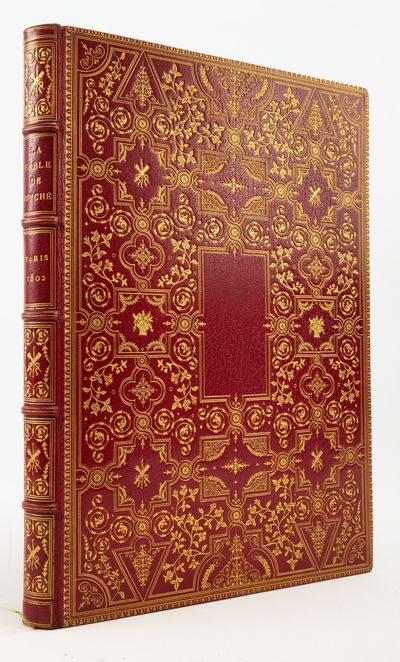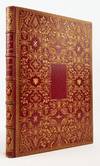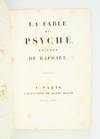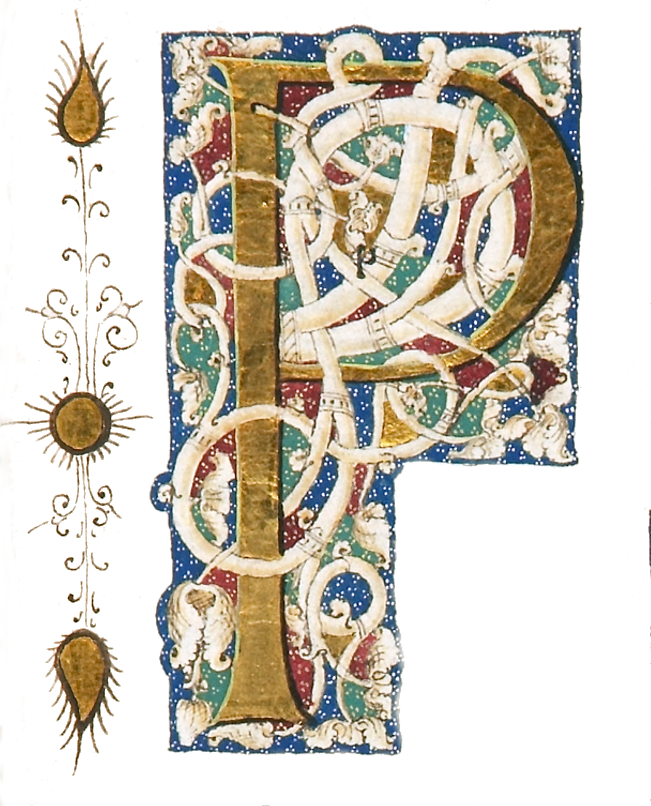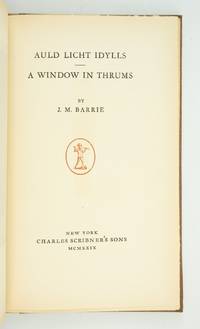An XI - 1802 · Paris
by (BINDINGS - PETIT and LE COMTE). APULEIUS, LUCIUS
Paris: Caractères de Henri Didot, An XI - 1802. Translated by Claude-Ignace Brugière de Barante. 340 x 240 mm. (13 1/2 x 9 1/2"). 4 p.l., 176 pp.
SPLENDID LATE 19TH CENTURY RED MOROCCO BY R. PETIT (stamp-signed on front turn-ins), LAVISHLY GILT À LA FANFARE BY J. LE COMTE (stamp-signed on rear turn-in), covers with animated design of lobed geometric compartments formed and connected by strapwork, the large rectangular centerpiece blank, the other compartments containing various tools, among them a flower basket, torch and fasces, fleuron, or filigree ornament, the spaces between the compartments filled with flowering vines and curling tendrils, the whole enclosed by gilt fillets and a tulip roll, raised bands, spine compartments with torch tool at center and spiraling tendrils at corners, gilt lettering, richly gilt turn-ins, blue-green watered silk pastedowns and endleaves, leather hinges, all edges marbled and gilt. Housed in an excellent felt-lined modern maroon morocco buckram clamshell box. WITH 33 ENGRAVINGS, consisting of frontispiece and 32 numbered plates, of designs AFTER RAPHAEL. A Large Paper Copy. Verso of front free endleaf with two engraved armorial bookplates, one belonging to Anthony J. Cefaratti. A breath of rubbing to extremities, minor foxing throughout due to acidic paper (a little more noticeable on the plates) otherwise A FINE COPY, the leaves fresh and bright with generous margins, IN A SPARKLING, UNWORN BINDING.
Sumptuously bound, attractively illustrated, with generous folio-sized proportions and wide margins, this is an especially pleasing copy of an ancient love story. Taken from "The Golden Ass," the major work by second century Roman writer and orator Lucius Apuleius, "Cupid and Psyche" is the tale of the obstacles faced by the god of love and his mortal wife. It is presented here in the original Latin as well as in French translation by Claude-Ignace Brugière de Barante (1745-1814), with an introduction by François Henri Stanislas de l'Aulnaye (1739-1830). It is accompanied by a lovely suite of illustrations after paintings by Raphael, reinterpreted by Frédéric Dubois (fl. ca. 1780–1819) and Pierre-Antoine Marchais (1763-1859) under the direction of Anne-Louis Girodet-Trioson (1767–1824) into almost modernist line engravings which nevertheless retain the softness of Raphael's originals. Our copy is distinguished by its ravishing fanfare-style binding. Executed by two of the lesser-known artisans working in Paris at the end of the 19th century, it proves that fame was not required to achieve the highest level of binding quality. Flety finds a number of binders named Petit working in Paris at the time; our R. Petit is most likely Rémy Petit, who had a rue Saint-Thomas-d'Aquin workshop which Flety tells us was operational through 1900. Our gilder Le Comte was likely the artisan of that name who was active on rue de Bourgogne in the third quarter of the 19th century. It was not uncommon for binders in Belle Epoque Paris to outsource the gilt decoration on their bindings to an expert doreur, especially when the design was as complex as what dazzles us here. Former owner Anthony J. Cefaratti (1918-2013) was a captain in the U.S. Army in World War II, and became a foreign service officer in the 1950s.. (Inventory #: ST20497)
SPLENDID LATE 19TH CENTURY RED MOROCCO BY R. PETIT (stamp-signed on front turn-ins), LAVISHLY GILT À LA FANFARE BY J. LE COMTE (stamp-signed on rear turn-in), covers with animated design of lobed geometric compartments formed and connected by strapwork, the large rectangular centerpiece blank, the other compartments containing various tools, among them a flower basket, torch and fasces, fleuron, or filigree ornament, the spaces between the compartments filled with flowering vines and curling tendrils, the whole enclosed by gilt fillets and a tulip roll, raised bands, spine compartments with torch tool at center and spiraling tendrils at corners, gilt lettering, richly gilt turn-ins, blue-green watered silk pastedowns and endleaves, leather hinges, all edges marbled and gilt. Housed in an excellent felt-lined modern maroon morocco buckram clamshell box. WITH 33 ENGRAVINGS, consisting of frontispiece and 32 numbered plates, of designs AFTER RAPHAEL. A Large Paper Copy. Verso of front free endleaf with two engraved armorial bookplates, one belonging to Anthony J. Cefaratti. A breath of rubbing to extremities, minor foxing throughout due to acidic paper (a little more noticeable on the plates) otherwise A FINE COPY, the leaves fresh and bright with generous margins, IN A SPARKLING, UNWORN BINDING.
Sumptuously bound, attractively illustrated, with generous folio-sized proportions and wide margins, this is an especially pleasing copy of an ancient love story. Taken from "The Golden Ass," the major work by second century Roman writer and orator Lucius Apuleius, "Cupid and Psyche" is the tale of the obstacles faced by the god of love and his mortal wife. It is presented here in the original Latin as well as in French translation by Claude-Ignace Brugière de Barante (1745-1814), with an introduction by François Henri Stanislas de l'Aulnaye (1739-1830). It is accompanied by a lovely suite of illustrations after paintings by Raphael, reinterpreted by Frédéric Dubois (fl. ca. 1780–1819) and Pierre-Antoine Marchais (1763-1859) under the direction of Anne-Louis Girodet-Trioson (1767–1824) into almost modernist line engravings which nevertheless retain the softness of Raphael's originals. Our copy is distinguished by its ravishing fanfare-style binding. Executed by two of the lesser-known artisans working in Paris at the end of the 19th century, it proves that fame was not required to achieve the highest level of binding quality. Flety finds a number of binders named Petit working in Paris at the time; our R. Petit is most likely Rémy Petit, who had a rue Saint-Thomas-d'Aquin workshop which Flety tells us was operational through 1900. Our gilder Le Comte was likely the artisan of that name who was active on rue de Bourgogne in the third quarter of the 19th century. It was not uncommon for binders in Belle Epoque Paris to outsource the gilt decoration on their bindings to an expert doreur, especially when the design was as complex as what dazzles us here. Former owner Anthony J. Cefaratti (1918-2013) was a captain in the U.S. Army in World War II, and became a foreign service officer in the 1950s.. (Inventory #: ST20497)
